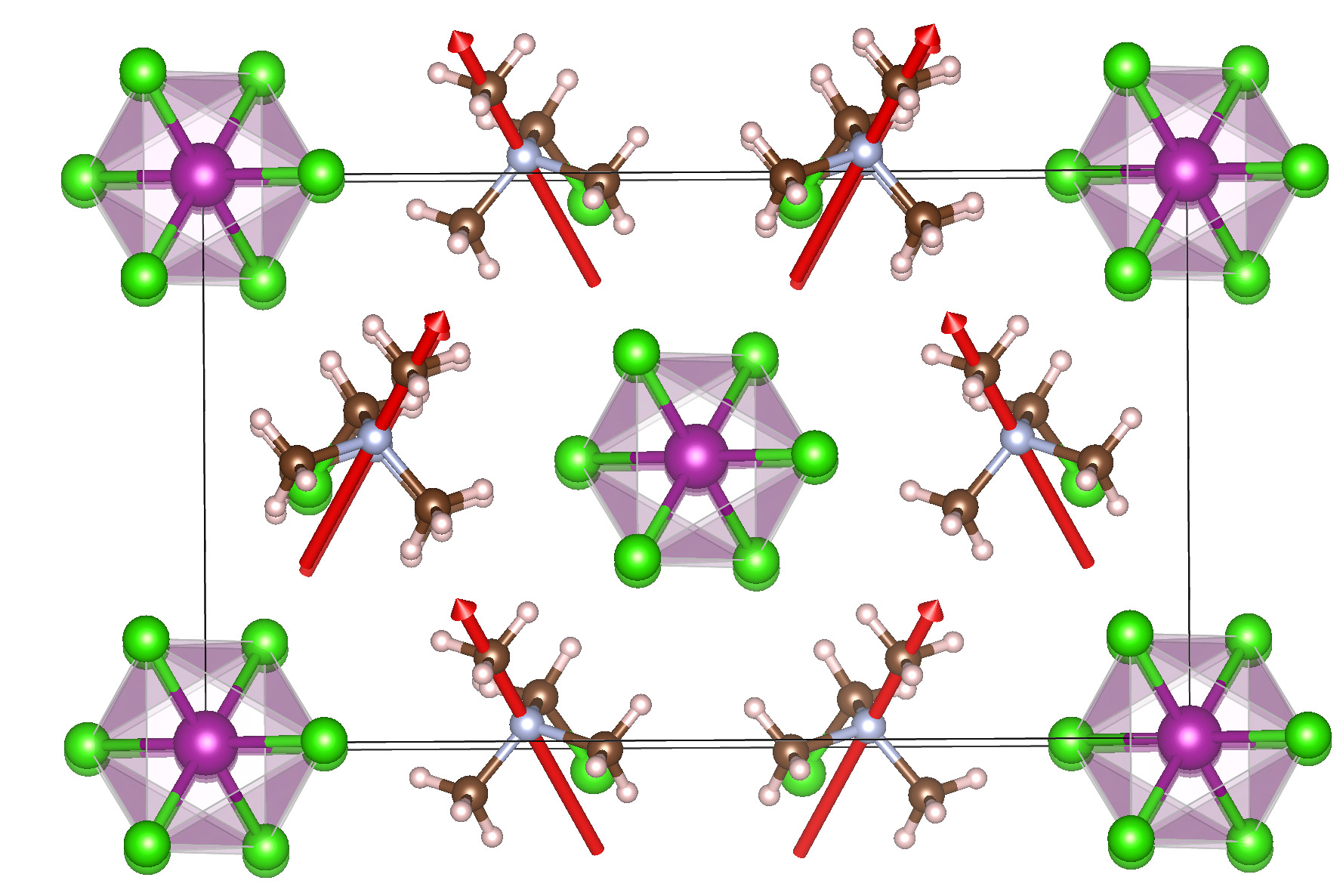 Ferroics and phase transitions. Ferroics are the materials that develop some spontaneous property. Examples are ferromagnets (develop spontaneous magnetization), ferroelectrics (develop spontaneous polarization) and ferroelastics (develop spontaneous strain). From fundamental science point of view we want to know why they develop the spontaneous property, how and under what conditions it happens, and whether we can interfere and alter it in a useful way. Ferroics find numerous applications such as in transformers, electromagnets, magnetic recording devices, capacitors, FeRAMs, ultrasound devices, night vision devices and many many more. Our research focuses on designing computational experiments to investigate these materials at finite temperatures and across different length and time scales. It roots in the fundamentals of statistical and quantum mechanics, electromagnetism, solid state physics, and materials science and applies them to discover properties and phenomena directly relevant to technological advances. Ferroics and phase transitions. Ferroics are the materials that develop some spontaneous property. Examples are ferromagnets (develop spontaneous magnetization), ferroelectrics (develop spontaneous polarization) and ferroelastics (develop spontaneous strain). From fundamental science point of view we want to know why they develop the spontaneous property, how and under what conditions it happens, and whether we can interfere and alter it in a useful way. Ferroics find numerous applications such as in transformers, electromagnets, magnetic recording devices, capacitors, FeRAMs, ultrasound devices, night vision devices and many many more. Our research focuses on designing computational experiments to investigate these materials at finite temperatures and across different length and time scales. It roots in the fundamentals of statistical and quantum mechanics, electromagnetism, solid state physics, and materials science and applies them to discover properties and phenomena directly relevant to technological advances.
Representative works:
- "Negative Longitudinal Piezoelectricity Coexisting with both Negative and Positive Transverse Piezoelectricity in Hybrid Formate Perovskite", Partha Sarathi Ghosh, S. Lisenkov and I. Ponomareva, ACS Appl. Mater. Interfaces 14, 46449 (2022).
- "Unusual properties of hydrogen-bonded ferroelectrics: the case of Co-formate", P.S. Ghosh, D. DeTellem, Junyu Ren, S. Witanachchi, Shengqian Ma, S. Lisenkov, and I. Ponomareva Phys. Rev. Lett., 128 077601 (2022).
- "Chemically and electrically tunable spin-polarizations in ferroelectric Cd-based hybrid organic-inorganic perovskites", Ravi Kashikar. P.S. Ghosh, S. Lisenkov, B. R. K. Nanda, and I. Ponomareva, Phys. Rev. B 104, 235132 (2021).
- "Phase switching as the origin of large piezoelectric response in organic-inorganic perovskites: A first-principles-study", P. S. Ghosh, S. Lisenkov, and I. Ponomareva, Phys. Rev. Lett., 125 207601 (2020).
|
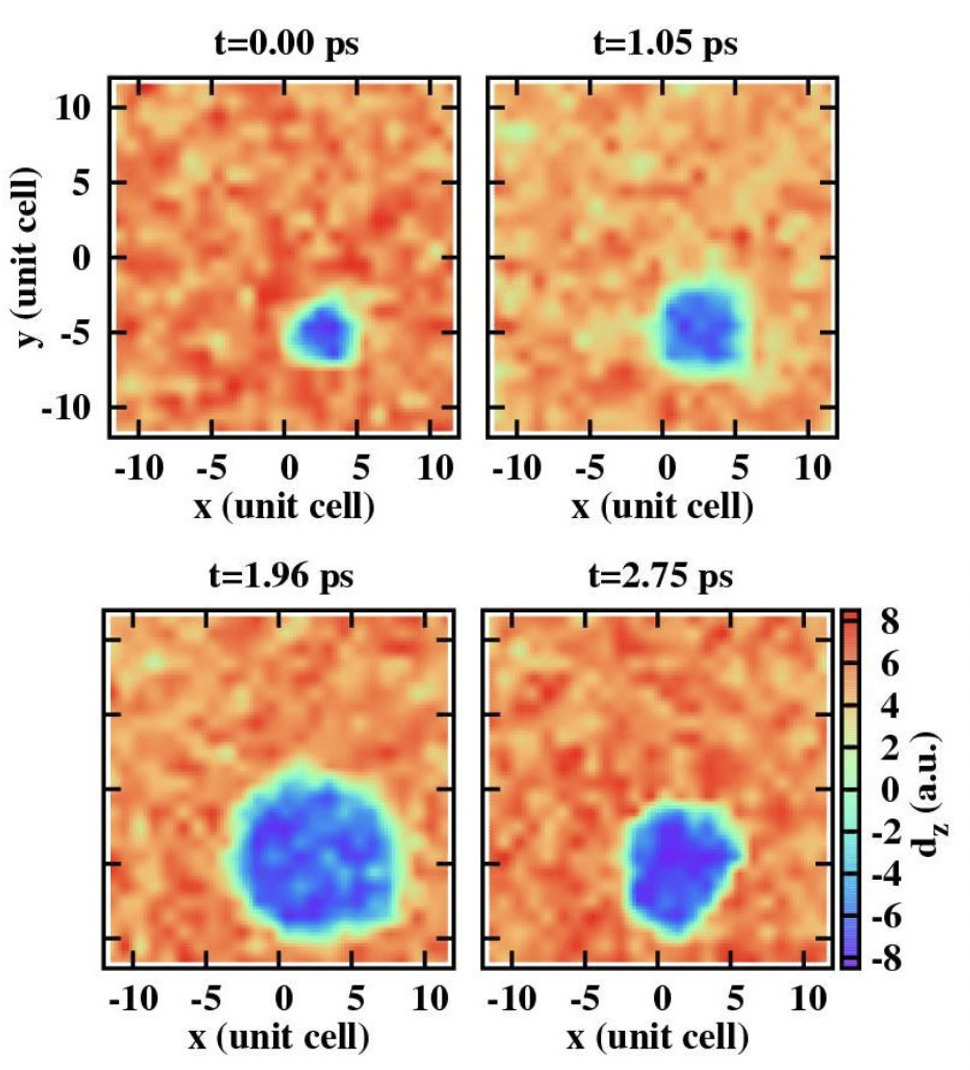 High-frequency dynamics and nanostructures. One of many remarkable features of ferroics is the strong dependence of their properties and behavior on time. At the fundamental level we seek to overcome the time resolution limitations inherent to experimental investigation and probe ferroics at ultra fast time scale in order to significantly advance our understanding of these materials. In particular, we can probe dynamics across timescales ranging from hundredths of femtosecond to several nanoseconds thus allowing for a unique insight into the origin of their phase transition, dynamics, unusual responses to the external perturbations and, many others. One example is the ultrafast inhomogeneous polarization reversal resolved at an atomistic level (see simulations snapshots).
Recall that many practical applications rely on ferroics and it becomes clear that the question of time dependence is of paramount practical importance. How fast can a device operate? Is there fundamental limit on its operational frequency? Are there any resonance phenomena that can lead to new functionality? Our research seeks answers to these questions from fundamental science point of view. High-frequency dynamics and nanostructures. One of many remarkable features of ferroics is the strong dependence of their properties and behavior on time. At the fundamental level we seek to overcome the time resolution limitations inherent to experimental investigation and probe ferroics at ultra fast time scale in order to significantly advance our understanding of these materials. In particular, we can probe dynamics across timescales ranging from hundredths of femtosecond to several nanoseconds thus allowing for a unique insight into the origin of their phase transition, dynamics, unusual responses to the external perturbations and, many others. One example is the ultrafast inhomogeneous polarization reversal resolved at an atomistic level (see simulations snapshots).
Recall that many practical applications rely on ferroics and it becomes clear that the question of time dependence is of paramount practical importance. How fast can a device operate? Is there fundamental limit on its operational frequency? Are there any resonance phenomena that can lead to new functionality? Our research seeks answers to these questions from fundamental science point of view.
Representative works:
- "Insight into pyroelectricty and phase transitions in ferroelectrics from nonequilibrium approach: The case of PbTiO3" , K. A. Lynch, T. Meng and I. Ponomareva, Adv. Theory Simul., 2200278 (2022).
- "Negative capacitance regime in antiferroelectric PbZrO3" , J. Doherty, K.A. Lynch and I. Ponomareva, J. Appl. Phys. 132, 034101 (2022).
- "Ba(Ti1-x,Zrx)O3 relaxors: dynamic ferroelectrics at gigahertz", S. Lisenkov, A. Ladera and I. Ponomareva, Phys. Rev. B , 102 224109 (2020).
- "Intrinsic dynamics of the electric-field-induced phase switching in antiferroelectric PbZrO3 ultrathin films",
Z. G. Fthenakis and I. Ponomareva, Phys. Rev. B 98, 054107 (2018).
|
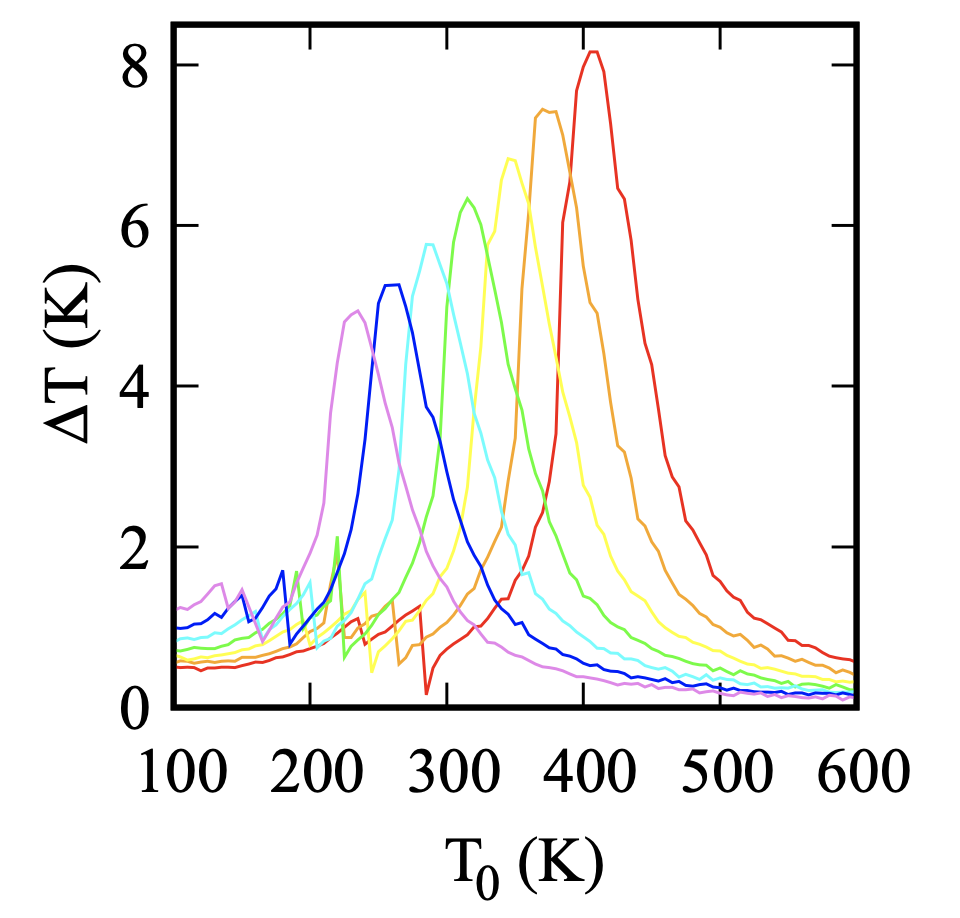 Caloric effects are associated with reversible change in temperature under adiabatic application of external fields. For example, adiabatic application of electric field to a dielectric or ferroelectric could increase its temperature (electrocaloric effect). Similarly, adiabatic application of external stress to an elastic or ferroelastic is likely to warm the sample (elastocaloric effect). In similar way a range of caloric effects can be obtained: magnetocaloric effect, barocaloric effect and even multicaloric effect, which occurs when several fields are applied at the same time. While known for decades, the basic caloric effects have hardly received any attention due to their deceiving simplicity and lack of practical value. Recent advances in thin samples fabrication revealed that giant caloric effects can exist at the nanoscale thus setting this direction onto "zero to hero" trajectory. Our research in this area led to the predictions of coexistence of negative and positive caloric effects in ferroelectrics, giant elastocaloric and multicaloric effects in ferroelectric ferroelastics, all of which have received experimental demonstration. Presently we extend our efforts into the exploration of caloric effects in new classes of ferroics and in ultra high frequency domain. Understanding these effects at the fundamental level is expected to enable their leap into realm of practical applications promising new type of refrigeration technology: environmentally friendly, light-weight and energy efficient. Perhaps, eventually enabling self-cooling wearables and finally making Florida the happiest place on Earth 🙂. Caloric effects are associated with reversible change in temperature under adiabatic application of external fields. For example, adiabatic application of electric field to a dielectric or ferroelectric could increase its temperature (electrocaloric effect). Similarly, adiabatic application of external stress to an elastic or ferroelastic is likely to warm the sample (elastocaloric effect). In similar way a range of caloric effects can be obtained: magnetocaloric effect, barocaloric effect and even multicaloric effect, which occurs when several fields are applied at the same time. While known for decades, the basic caloric effects have hardly received any attention due to their deceiving simplicity and lack of practical value. Recent advances in thin samples fabrication revealed that giant caloric effects can exist at the nanoscale thus setting this direction onto "zero to hero" trajectory. Our research in this area led to the predictions of coexistence of negative and positive caloric effects in ferroelectrics, giant elastocaloric and multicaloric effects in ferroelectric ferroelastics, all of which have received experimental demonstration. Presently we extend our efforts into the exploration of caloric effects in new classes of ferroics and in ultra high frequency domain. Understanding these effects at the fundamental level is expected to enable their leap into realm of practical applications promising new type of refrigeration technology: environmentally friendly, light-weight and energy efficient. Perhaps, eventually enabling self-cooling wearables and finally making Florida the happiest place on Earth 🙂.
Representative works:
- "Hidden variable in the electrocaloric effect of ferroics", Ravi Kashikar, Subhashree Chatterjee, Folarin Shola Taofeek,
Abhisikta Barman, Shubhankar Barman, Sohini Kar-Narayan, Anuja
Datta, Sergey Lisenkov, Devajyoti Mukherjee, and I. Ponomareva, Phys. Rev. Materials 6, 124403 (2022).
- "Multicaloric effect in ferroelectric PbTiO3 from first principles",
S. Lisenkov, B. K. Mani, C.-M. Chang, J. Almand, and I. Ponomareva, Phys. Rev. B 87, 224101 (2013).
- "Giant elastocaloric effect in ferroelectric (Ba0.5,Sr0.5)TiO3 alloys",
S. Lisenkov and I. Ponomareva, Phys. Rev. B 86, 104103 (2012).
|
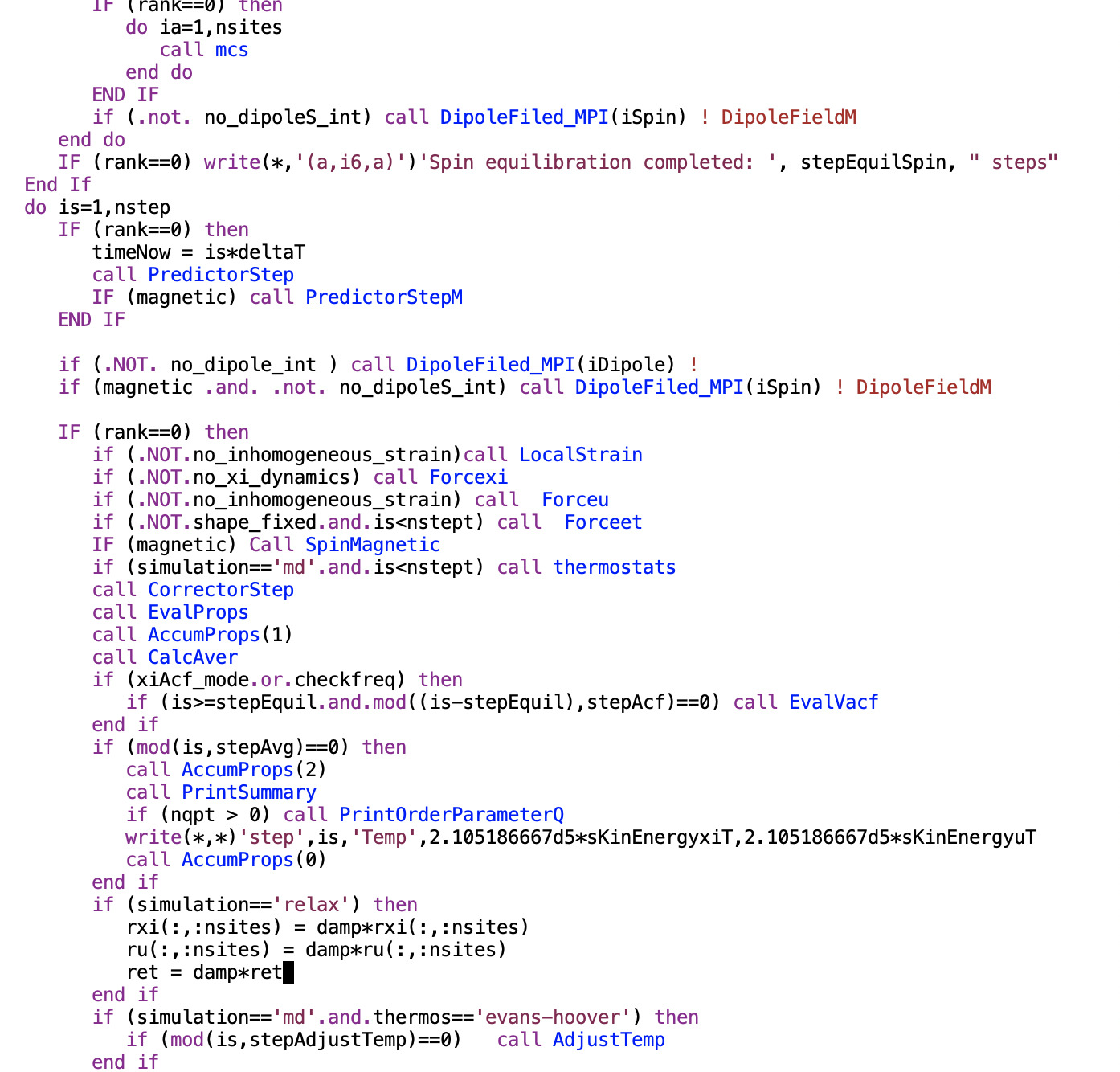 Methodology and implementation. To achieve our scientific goals we design and carry out computational experiments that utilize high-performance computing. Our computational tools range from first-principles Density Functional Theory (DFT) based codes to classical potentials that enable finite-temperature simulations at realistic time and size scales. For example, we use DFT simulations to develop accurate interatomic potentials for ferroics which we implement in Molecular Dynamics, Monte Carlo, replica exchange Monte Carlo, evolutionary algorithms, and other techniques. Often times we aim to extend the reach of these techniques to simulate new types of thermodynamical ensembles, such as isentropic Monte Carlo that allowed for atomistic direct simulations of caloric effects. Presently we implement machine learning algorithms to enable new type of physical insights into ferroics beyond traditional human-driven analysis and interpretation. Methodology and implementation. To achieve our scientific goals we design and carry out computational experiments that utilize high-performance computing. Our computational tools range from first-principles Density Functional Theory (DFT) based codes to classical potentials that enable finite-temperature simulations at realistic time and size scales. For example, we use DFT simulations to develop accurate interatomic potentials for ferroics which we implement in Molecular Dynamics, Monte Carlo, replica exchange Monte Carlo, evolutionary algorithms, and other techniques. Often times we aim to extend the reach of these techniques to simulate new types of thermodynamical ensembles, such as isentropic Monte Carlo that allowed for atomistic direct simulations of caloric effects. Presently we implement machine learning algorithms to enable new type of physical insights into ferroics beyond traditional human-driven analysis and interpretation.
Representative works:
- "Machine learning reveals memory of the parent phases in ferroelectric relaxors Ba(Ti1-x,Zrx)O3", Adriana Ladera, Ravi Kashikar, S. Lisenkov and I. Ponomareva, Adv. Theory Simul., 2200690 (2023).
- "Insight into pyroelectricty and phase transitions in ferroelectrics from nonequilibrium approach: The case of PbTiO3" , K. A. Lynch, T. Meng and I. Ponomareva, Adv. Theory Simul., 2200278 (2022).
- "High-frequency intrinsic dynamics of the electrocaloric effect from direct atomistic simulations",
S. Lisenkov and I. Ponomareva, Phys. Rev. B 97, 184104 (2018).
- "Enhancement of electrocaloric response through quantum effects",
P. Jouzdani, S. Cuozzo, S. Lisenkov, and I. Ponomareva, Phys. Rev. B 96, 214107 (2017).
|
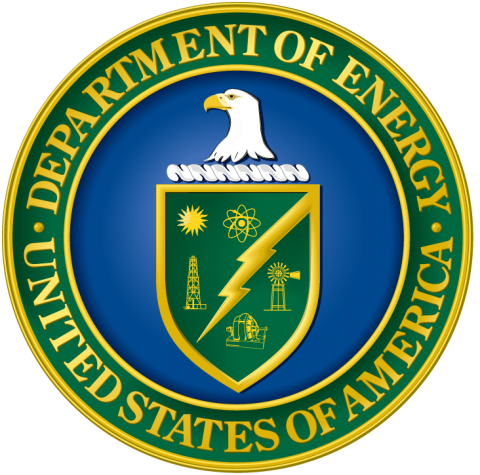  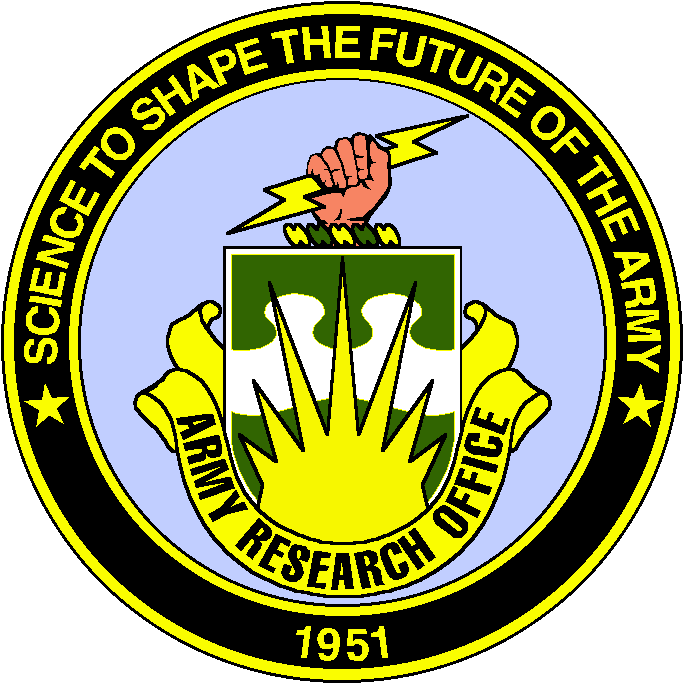 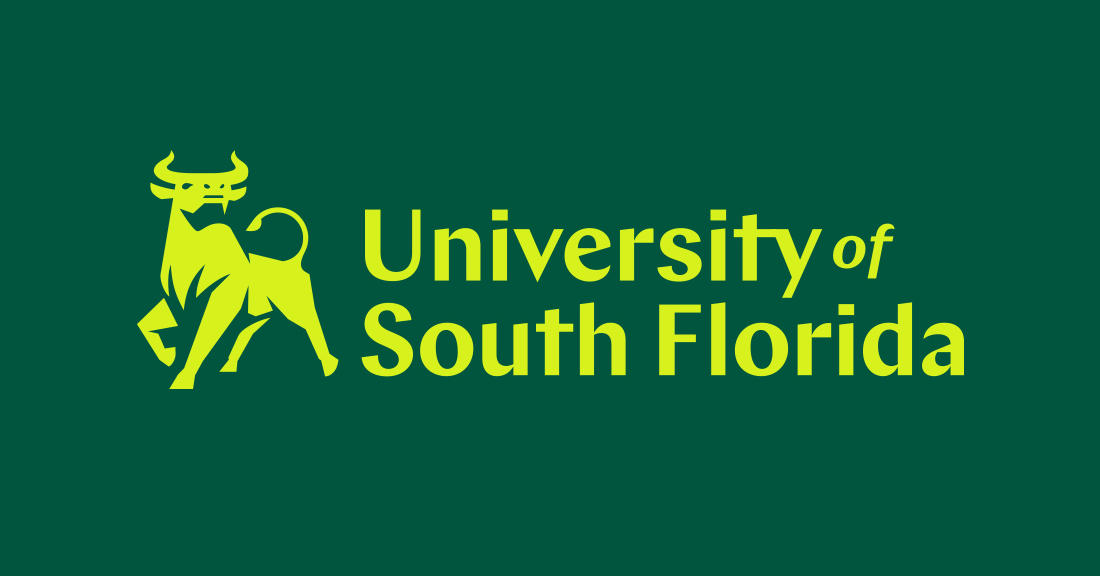 Financial support from DOE, NSF, ARO, and USF is greately acknowledged. Financial support from DOE, NSF, ARO, and USF is greately acknowledged. |